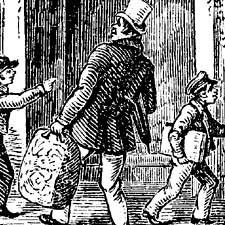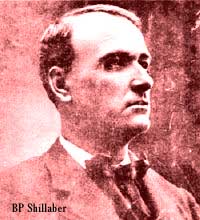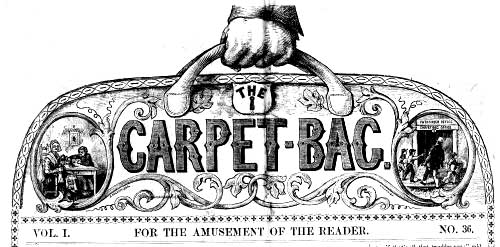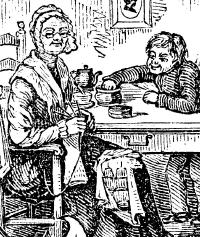|
FRESH STUFF DAILY |
|
|
||
|
|
||
|
|
||
|
SEE ALL SIGNED BOOKS by J. Dennis Robinson click here |
||
Page 1 of 2
READ: Blood on the Snow in Portsmouth
Published weekly in Boston "for the amusement of the reader", The Carpet Bag survived only two years and earned only a few hundred subscribers. But when it appeared in Boston in 1851 it was -- by design -- the biggest joke in town. Jazz, baseball and comedy are among the nation's chief cultural exports. American humor, according to one Mark Twain scholar, is as much an institution as the Declaration of Independence. As editor of the first weekly humor periodical before the Civil war, Shillaber has been called the "torch-bearer" for the great humorists that followed. Two of them, Mark Twain and Artemus Ward, were "discovered" and first published by Shillaber. It is the 19th century version of Jack Paar discovering the likes of Woody Allen, Jonathan Winters and the Smothers Brothers on his early weekly television show. What amuses a nation, however, shifts with time. The importance of The Carpet Bag may be lost to modern generations weaned on slapstick, racial epithets, cruel parody, snappy one-liners, biting satire, toilet jokes and adult-rated comedy. Revolutionary as it was, BP Shillaber's concept of a household humor magazine was closer to a modern Reader's Digest than to National Lampoon. His homespun humor was designed to "promote cheerfulness" and specifically not to "make the vulgar laugh". The Carpet Bag, he explained in the first issue, was open to "a good joke or a pleasant satire or a harmless witticism". Comedy, Shillaber believed, was created to uplift, not put down. The magazine, essentially, reflected the man, jovial and good-natured. He was born in Portsmouth, New Hampshire in 1814 as the second war with England waned. Educated in the local schools, Benjamin Shillaber was well liked by his classmates, despite his penchant for playing practical jokes. Well-mannered and even tempered, the sandy-haired boy "was always apologetic if he hurt anyone's feelings" one of his classmates later recalled.
Like many American humorists to follow, Shillaber entered the newspaper business instead of college. At 15 he set type and washed out the forms for the New Hampshire Palladium in nearby Dover. The boy loved his work, got along with other employees and was soon running the press, but like his own newspaper to come, the Palladium folded after a valiant two-year run. With the Portsmouth economy on the skids, 19-year old BP Shillaber joined an exodus of young rural men searching for work in the big city. What Shillaber brought with him to Boston -- his down-home memories of growing up in provincial Portsmouth, became the heart and soul of his comedy. His most enduring and witty character, Mrs. Ruth Partington, became the very symbol of a rising middle class searching for a code of manners to follow in a new world suddenly dominated by cities and technology. She was the country bumpkin in the city and when Mrs. Partington talked, America laughed. Shillaber developed his best character, likely fashioned after his Portsmouth aunt, while writing for the Boston Post. By this time he was a mature writer, had lived for a while in South America, moved back to Boston and married. The concept of the Carpet Bag was loosely adapted from the British humor magazine Punch and proceeded the more successful New York magazine Vanity Fair begun in 1859. The mixed bag of articles included humorous illustrations, poetry, rambling commentaries by the ever-popular Mrs. Partington and other fictional characters. One issue featured the life of an imaginary Maine veteran wounded in the Aroostook Wars when he tripped over the chuck wagon. Another piece delved into the constitutionality of donuts. Contributors wrote, not for the meager payments, but because they admired Shillaber and liked the idea. Shillaber, rotund and always friendly, was a popular Boston figure for many years and, admirers agreed, never made an enemy. "Should the reader meet him in the street," one contemporary wrote of Shillaber, "he would take him for an unsophisticated, backwoodsman, and not an associate editor of one of the most influential journals in the United States. He is as genial as the sunshine, and generous to a fault – sensitive, gallant, courteous, and urbane." Shillaber had two Boston partners working in the second floor office of the humor magazine that actually began as a railroad timetable broken up by funny bits, much in the spirit of Ben Franklin’s Poor Richard’s Almanac. The three owners printed many more copies than the 400 that sold weekly and soon the office was piled to the ceiling with back issues of the Carpet Bag. The magazine hired a young compositor named Charles Browne from Maine who secretly contributed his first humor sketch to the Carpet Bag and was thrilled to see it published. Under the pseudonym Artemus Ward, Browne later became one of the nations most popular humor writers. On May 1, 1852 the Carpet Bag made literary history when it published a short piece titled "The Dandy Frightening the Squatter" and signed with the initials SLC. To date, this is the earliest known publication by a young Samuel Longhorn Clemens, the future Mark Twain. Twain’s elder brother Orion Clemens, editor of the Hannibal Journal was a subscriber to the Carpet Bag and sometimes reprinted its contents in his Missouri newspaper. In all the Carpet Bag published the work of about 100 writers. It proved, despite its failure, that there was a uniquely American brand of humor and encouraged the careers of the great rush of comic writers who followed after the Civil War.
Despite the death of four of his children and eventually his wife, though crippled and confined to a wheelchair in his Chelsea home, Shillaber remained impossibly jovial. "Ache on," he reportedly said to his paralyzed legs. "I can stand it if you can." In the voice of his aged heroine Mrs. Partington, Shillaber told an interviewer that he had no fear of death. "I believe I have done the world some good by adding to it’s happiness," Mrs Partington told her interviewer while sitting up in her bed. "People have laughed with me, or at me, no matter which, and no one will condone me to everlasting perdition… But please excuse me, I am very weary, and I know you must be tiresome." Benjamin P Shillaber and Mrs. Ruth Partington died simultaneously on November 24, 1890. The author noted that his life was "no great affair", but that in 40 years as a writer and editor he had "never willingly wounded the feelings of a single worthy soul." Few newspaper editors, it is safe to assume, have died with a clearer conscience. SOURCES: Only two thin volumes on the life of BP Shillaber exist. They are: Shillaber by Cyril Clemens (Mark Twain's nephew), 1946, and Benjamin Penhallow Shillaber by John Q. Reed, 1972. SEE ALSO: Frenchman's Lane SEE LARGER PICTURES from the Carpet-Bag
Please visit these SeacoastNH.com ad partners.
News about Portsmouth from Fosters.com |
| Tuesday, April 16, 2024 |


|
Copyright ® 1996-2020 SeacoastNH.com. All rights reserved. Privacy Statement
Site maintained by ad-cetera graphics

 HISTORY
HISTORY




 Copies are hard to come by, but hard to miss. The elaborately illustrated masthead shows a human hand grasping the leather handle of a fabric-covered bag, the all-purpose 19th century equivalent of a backpack. Today this cheap, floppy, flat-bottomed bit of luggage carries a negative connotation; it will be forever associated with the "carpetbaggers" who hurried to exploit the South after the Civil War. But to Shillaber's earlier audience, a carpetbag was simply a place to keep all sorts of household stuff. His new publication, he explained, was to be the literary equivalent -- stuffed to bursting with bits of prose and poetry that were just too precious to throw away.
Copies are hard to come by, but hard to miss. The elaborately illustrated masthead shows a human hand grasping the leather handle of a fabric-covered bag, the all-purpose 19th century equivalent of a backpack. Today this cheap, floppy, flat-bottomed bit of luggage carries a negative connotation; it will be forever associated with the "carpetbaggers" who hurried to exploit the South after the Civil War. But to Shillaber's earlier audience, a carpetbag was simply a place to keep all sorts of household stuff. His new publication, he explained, was to be the literary equivalent -- stuffed to bursting with bits of prose and poetry that were just too precious to throw away.
 Even the closing of his beloved publication did nothing to diminish Shillaber’s good humor. He quickly collected his own writings into his first book, "
Even the closing of his beloved publication did nothing to diminish Shillaber’s good humor. He quickly collected his own writings into his first book, "














